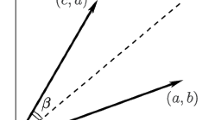Abstract
We present a deterministic algorithm, which, for any given \(0< \epsilon < 1\) and an \(n \times n\) real or complex matrix \(A=\left( a_{ij}\right) \) such that \(\left| a_{ij}-1 \right| \le 0.19\) for all \(i, j\) computes the permanent of \(A\) within relative error \(\epsilon \) in \(n^{O\left( \ln n -\ln \epsilon \right) }\) time. The method can be extended to computing hafnians and multidimensional permanents.
Similar content being viewed by others
References
S. Aaronson and A. Arkhipov, The computational complexity of linear optics, Theory of Computing 9 (2013), 143–252.
G. Ausiello, P. Crescenzi, G. Gambosi, V. Kann, A.Marchetti-Spaccamela, and M. Protasi, Complexity and Approximation.Combinatorial Optimization Problems and their Approximability Properties, Springer-Verlag, Berlin 1999.
A. Barvinok, Two algorithmic results for the traveling salesman problem, Mathematics of Operations Research 21 (1996), no. 1, 65–84.
A. Barvinok, Polynomial time algorithms to approximate permanents and mixed discriminants within a simply exponential factor, Random Structures & Algorithms 14 (1999), no. 1, 29–61.
A. Barvinok, Computing the partition function for cliques in a graph, preprint arXiv:1405.1974 (2014).
A. Barvinok and A. Samorodnitsky, Computing the partition function for perfect matchings in a hypergraph, Combinatorics, Probability and Computing 20 (2011), no. 6, 815–835.
A. Barvinok and P. Soberón, Computing the partition function for graph homomorphisms, preprint arXiv:1406.1771 (2014).
J. Draisma, E. Horobet, G. Ottaviani, B. Sturmfels and R.R. Thomas, The Euclidean distance degree of an algebraic variety, preprint arXiv:1309.0049 (2013).
S. Friedland and L. Gurvits, Generalized Friedland-Tverberg inequality: applications and extensions, preprint arXiv:0603410 (2006).
M. Fürer, Approximating permanents of complex matrices, Proceedings of the Thirty-Second Annual ACM Symposium on Theory of Computing, ACM, New York 2000, pp. 667–669.
D. Gamarnik and D. Katz, A deterministic approximation algorithm for computing the permanent of a 0, 1 matrix, Journal of Computer and System Sciences 76 (2010), no. 8, 879–883.
L. Gurvits, On the complexity of mixed discriminants and related problems, Mathematical Foundations of Computer Science 2005, Lecture Notes in Computer Science, vol. 3618, Springer, Berlin, 2005, pp. 447–458.
L. Gurvits and A. Samorodnitsky, Bounds on the permanent and some applications, preprint arXiv:1408.0976 (2014).
M. Jerrum, A. Sinclair and E. Vigoda, A polynomial-time approximation algorithm for the permanent of a matrix with nonnegative entries, Journal of the ACM 51 (2004), no. 4, 671–697.
N. Linial, A. Samorodnitsky, and A. Wigderson, A deterministic strongly polynomial algorithm for matrix scaling and approximate permanents, Combinatorica 20 (2000), no. 4, 545–568.
H. Minc, Permanents. Encyclopedia of Mathematics and its Applications, Vol. 6, Addison-Wesley Publishing Co., Reading, Mass., 1978.
A.D. Scott and A.D. Sokal, The repulsive lattice gas, the independent-set polynomial, and the Lovász local lemma, Journal of Statistical Physics 118 (2005), no. 5–6, 1151–1261.
L.G. Valiant, The complexity of computing the permanent, Theoretical Computer Science 8 (1979), no. 2, 189–201.
Acknowledgments
The author is grateful to the anonymous referees for their careful reading of the paper, useful suggestions and interesting questions.
Author information
Authors and Affiliations
Corresponding author
Additional information
Communicated by Stephen Cook.
This research was partially supported by NSF Grants DMS 0856640 and DMS 1361541.
Rights and permissions
About this article
Cite this article
Barvinok, A. Computing the Permanent of (Some) Complex Matrices. Found Comput Math 16, 329–342 (2016). https://doi.org/10.1007/s10208-014-9243-7
Received:
Revised:
Accepted:
Published:
Issue Date:
DOI: https://doi.org/10.1007/s10208-014-9243-7



